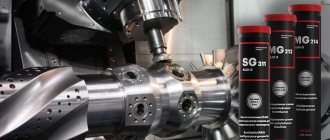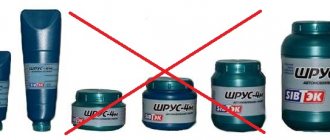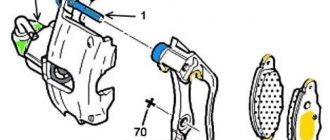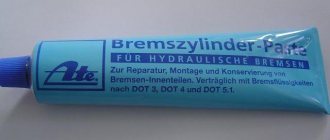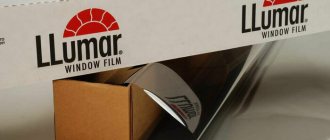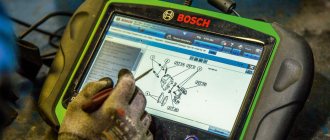Graphite grease - an inorganic lubricant, black or dark brown in color, with a dense and highly viscous consistency. Outwardly it resembles the well-known solid oil. The lubricant is made from vegetable fats using petroleum cylinder oil fluids and lithium or calcium soaps, as well as graphite. Graphite powder is used as the latter. In accordance with GOST 3333-80, according to which it is manufactured, the optimal temperature of use is from -20°C to +60°C, but in fact it can withstand more critical temperatures. Graphite lubricant is widely used in industry, as well as in automobile transport. In particular, it is used to coat springs, suspension elements, heavily loaded bearings, open gears, and so on.
Composition of graphite grease
First of all, you need to know that in the technical literature the concept of “graphite lubricant” can be understood as various compositions. The fact is that initially this definition refers to an inorganic lubricant for which graphite is used as a thickener, but in a broad sense this is also the name for lubricants where graphite is used as an additive. Thus, the term “graphite lubricant” may mean:
Crushed graphite
- ordinary graphite powder, which can be used as a solid lubricant;
- soap-based lubricant containing graphite;
- graphite suspension in oil solution (inorganic lubricant).
It is the latter composition that is most often called graphite lubricant and will be discussed further. Its manufacturing technology involves thickening viscous organic or synthetic oil, which is obtained from petroleum products, with calcium soap and graphite powder. In other words, we can say that graphite powder is added to classic grease, which gives the lubricant its properties.
Graphite powder itself has a soft consistency. Therefore, as part of the lubricant, it fills irregularities on the working surfaces of parts, thus reducing friction.
Currently, copper-graphite grease can also be found on sale. Copper powder has been added to its composition. It is able to withstand high temperatures. Typically, copper-graphite lubricant is available in the form of aerosols. Looking ahead, we will say that this composition is often applied to the caliper guides. This will prevent the brake drums and/or discs from sticking to the hub flanges.
Properties of graphite grease
Graphite itself is a good conductor of heat and electricity, is not destroyed by moisture, is not affected by static electricity, and is also thermally stable (can withstand high temperatures). The corresponding lubricant also has all these properties, although to a lesser extent.
What is good about graphite lubricant? Its advantages include:
- chemical resistance (when lubricant is applied to working surfaces, its elements do not react chemically with it);
- thermal stability (does not evaporate up to a temperature of +150°C, since the concentration of volatile substances in its composition is minimal, and does not lose its performance characteristics at high temperatures);
- protects work surfaces from moisture;
- has increased colloidal stability;
- explosion-proof;
- has excellent lubricating properties;
- increases wear resistance, mechanical performance and service life of the mechanism where it is used;
- minimizes the number of jams;
- not affected by oil, that is, remains on the surface even if it is present;
- graphite lubricant adheres perfectly to any surface;
- resistant to static electricity;
- has high adhesive and anti-friction properties.
Another important advantage of graphite lubricant is its low price with satisfactory performance characteristics . Although, in fairness, it should be noted that currently there are many other, more advanced lubricants that, although more expensive, have better performance.
However, graphite lubricant also has disadvantages. In particular, it cannot be used in mechanisms with high operating precision, since solid impurities present in graphite will contribute to increased wear of parts;
Advantages and disadvantages
Today, a variety of mechanisms are lubricated with the substance in question. This comes with quite a lot of advantages. An example is the following:
- The temperature range is very wide, it varies from -20 to 70 degrees Celsius. Some manufacturers produce products that are designed for increased load.
- This substance is also characterized by good water-repellent properties. An example is silicone grease, which has reduced electrical conductivity.
- The coating is protected from exposure to high humidity. In other words, graphite-based lubricants eliminate the possibility of corrosion.
The use of modern production technologies has made it possible to significantly expand the performance characteristics.
There are also several significant disadvantages that must be taken into account. An example is the inability to use it to protect parts characterized by high precision. This is due to the fact that operation in this case causes increased wear of parts. It also cannot be used if the device is operating at high speed.
The differences between Litol and the product in question are insignificant. That is why many decide to replace it if possible. An example is applications in cars and many other household devices.
In conclusion, we note that graphite lubricant is a modern offering on the market. By adding a certain impurity to the composition, performance characteristics in various temperature conditions are significantly increased.
If you find an error, please select a piece of text and press Ctrl+Enter.
Lubricants containing copper and graphite have become widespread in many sectors of the mechanical engineering complex, including machine tool and tool industry, road construction and agricultural engineering. Mechanics value this product, classified as an industrial lubricant, for its low consumption, as well as high technical and physicochemical properties, which allow the composition to be used in aggressive environments, in a wide temperature range, under heavy loads and high pressure. All this allows you to extend the useful life of equipment and reduce the likelihood of premature failure of parts.
Read also: Do-it-yourself lift for a router video
Characteristics
The current GOST 3333-80, as well as the corresponding technical conditions, indicate the technical and operational characteristics of graphite lubricant.
| Characteristic | Meaning |
| Temperature range of application | from -20°С to +60°С (however, it is allowed to use lubricant at temperatures below -20°С in springs and similar devices) |
| Density, g/cm³ | 1,4…1,73 |
| Dropping point | not lower than +77°С |
| Penetration at +25°C with stirring (60 double strokes) | not less than 250 mm/10 |
| Colloidal stability, % of released oil | no more than 5 |
| Mass fraction of water | no more than 3% |
| Shear strength at +50°C | not less than 100 Pa (1.0 gf/cm²) |
| Viscosity at 0°C at an average strain rate gradient of 10 1/s | no more than 100 Pa•s |
| Tensile strength at +20°С, kg/cm² | |
| tensile | 120 |
| for compression | 270…600 |
| Electrical resistance | 5030 ohm•cm |
| Temperature, °C | |
| decomposition | 3290 |
| maximum permissible operating | 540 |
| average permissible operational | 425 |
| Lubricant oxidation products | CO, CO2 |
| NLGI class | 2 |
| Designation according to GOST 23258 | Ska 2/7-g2 |
When working with lubricant, you must remember and follow the rules below for the safe use of graphite lubricant.
When working with lubricant, observe the following safety and fire safety rules:
- Graphite grease is explosion-proof, its flash point is +210°C.
- If a spill occurs on the surface, the lubricant should be collected in a container, the spill area should be wiped dry with a rag, which should then be placed in a separate, preferably metal, box.
- In the event of a fire, the main fire extinguishing agents are used: finely sprayed water, chemical, air-chemical foam, high-expansion foam and appropriate powder compositions.
The guaranteed shelf life of the lubricant is five years from the date of manufacture.
Application area
The scope of application of graphite lubricant is very wide. In production it is lubricated with:
- special equipment springs;
- low-speed bearings;
- open and closed shafts;
- various gears;
- shut-off valves;
- suspensions in large-sized mechanisms, special equipment;
- drilling rig supports.
Now we will briefly list the components and mechanisms of the car that can be lubricated with this composition (taking into account some features):
- steering joints;
- steering rack (in particular, the rack body is disassembled and the working gear is lubricated);
- elements of the steering mechanism (with the exception of those where transmission oils are used as lubricant);
- ball joints;
- anti-squeak washers in springs;
- anthers of steering tips and rods;
- support bearings;
- steering knuckle bearings (for prevention, grease is also packed into a protective cap);
- cable drive of the parking brake;
- car springs;
- on rear-wheel drive vehicles it can be used for driveshaft crosspieces.
Graphite lubricant can also be used as a prophylactic agent. In particular, it can be used to lubricate threaded connections, ordinary and car locks in summer and especially in winter .
Many car enthusiasts are also interested in the question of whether it is possible to lubricate CV joints (constant velocity joints) with graphite. There is no clear answer in this case. If we are talking about cheap domestic lubricant, then you should not risk it, it can ruin the internal mechanism of the hinge. If you use imported expensive lubricant (for example, Molykote BR2 plus, Molykote Longterm 2 plus, Castrol LMX and other materials containing graphite), then you can try. However, remember that there are special lubricants for CV joints.
CV joint lubrication
Timely lubrication of the CV joint reduces its wear and extends its service life. Each type of hinge requires its own type of lubricant. Find out which one needs to be smeared and which is better from reviews and a review of characteristics. More details
Do not forget that graphite lubricant is intended for use in low-speed mechanisms and where greater precision is not required.
It is worth dwelling separately on the question of whether it is possible to lubricate battery terminals with graphite grease. Yes, its composition conducts electricity, but there is a risk of overheating due to the fact that it has a high resistivity. Therefore, it is possible to use “graphite” to lubricate the terminals, but it is not advisable . The lubricant will prevent the surface from corroding. Therefore, it is better to use other means to lubricate the battery terminals.
How to lubricate battery terminals
Lubricants for battery terminals can range from traditional “old-fashioned” ways to protect battery terminals from oxidation, to modern ones, with impurities that improve electrical conductivity. More details
How to remove graphite grease
Using lubricant without care can easily stain your clothes. And it will no longer be easy to remove it, because it is not only grease, but also graphite, which is difficult to wipe off. Therefore, a very interesting question arises: what can you use to wash or wipe off graphite grease. There are many different debates and opinions on this matter on the Internet. We offer your opinion several remedies that should help with this (the fact is that in each individual case different remedies can help, it all depends on the degree of contamination, type of fabric, duration of contamination, additional impurities, and so on). So, they will help you:
Antipyatin
- gasoline (preferably 98, or pure aviation kerosene);
- grease remover (for example, Antipyatin);
- "Sarma gel" for dishes;
- contactless shampoo for car washing (spray the aerosol onto dirt, then try to gently wipe off);
- hot soapy solution (if the contamination is not severe, you can soak the clothes for a while in a solution of laundry soap, and then scrub them by hand);
- “Vanish” (similarly, you need to pre-soak the clothes and let them stand for several hours; you can wash them by hand or in a washing machine).
Some car owners recommend washing clothes in a washing machine at maximum temperature. Remember that this is not acceptable for some types of fabrics! They may lose their structure and the clothing cannot be restored. Therefore, read what is indicated on the corresponding label on the clothing, in particular, at what temperature the product can be washed.
Is it always necessary to protect terminals from oxidation?
In a technically sound car with a good battery that does not have cracks in the case, including those caused by excessive force when tightening the terminals, their oxidation occurs very slowly. If the car is parked in a dry and ventilated place, the risk of contact deterioration is further reduced.
Nevertheless, no matter what ideal conditions the car is operated in, oxidation and burning of contacts inevitably occurs, which is most pronounced at the battery terminals, where huge currents of hundreds of amperes pass at the moment the starter is started. In addition, there is always water vapor and oxygen in the air, which slowly but surely lead to corrosion of metals.
If there is a whitish coating, which most often occurs on the positive terminal of the battery, the use of a protective lubricant makes it possible to continue operating the car if it is not possible to replace the battery. To do this, you need to clean the contacts, place felt pads soaked in grease between the battery case and the terminals, connect them to the conductors, tighten and lubricate the contact connection on top. The negative terminal also needs protection from burnouts and oxidation, due to the constant presence in the hot engine compartment with road dust and moisture.
- etlib.ru
- avtotehnar.ru
- automanya.ru
How to make graphite grease with your own hands
DIY graphite lubricant
Due to the popularity of graphite lubricant among auto repairmen, as well as the simplicity of its composition, there are several traditional methods by which you can make this lubricant at home.
You need to take graphite powder, solid oil and machine oil. Their ratio may be different. The basis is liquid oil, to which grease is added, and then graphite (you can use ground pencil lead or worn brushes of an electric motor or current collector). Next, this mass must be stirred until a consistency similar to sour cream is obtained. Instead of machine oil, you can use transmission oil.
However, it is necessary to understand that homemade mixtures will not meet the stated GOST, therefore such lubricants will not meet its standards. In addition, the shelf life of homemade graphite lubricants will be significantly lower than the factory one.
Copper-graphite grease
As mentioned above, an improved version of the classic graphite grease is copper-graphite grease. From the name it is clear that copper powder has been added to its composition, which significantly improves its performance properties. Features of the composition of copper-graphite lubricant include:
Copper-graphite grease
- ability to work at high temperatures (in this case it is impossible to indicate a clear range, since there are different compositions on the market with different properties, some of them are able to work at temperatures of about +1000°C and above, read the details in the description of the product);
- ability to withstand high mechanical loads (similar to the previous point);
- increased level of adhesion and stickiness;
- complete elimination of corrosion formations on protected surfaces;
- resistance to oil and moisture;
- The lubricant does not contain lead, nickel and sulfur.
Thus, copper-graphite lubricant perfectly protects working surfaces even under extreme operating conditions. Often, threaded connections are treated with this product before connecting them. This makes it possible to unscrew the connection in the future without any problems.
Popular manufacturers
Finally, let’s briefly look at some domestic manufacturers producing graphite lubricant. It’s worth saying right away that their products are largely similar to each other, so it doesn’t really matter what brand of lubricant you buy. Domestic graphite lubricant meets GOST 3333-80, so all products will be approximately the same.
According to old Soviet standards, graphite lubricant had the designation “USsA”.
So, in the post-Soviet space the production of graphite lubricant is carried out by:
- LLC "Colloidal-graphite preparations". This company produces graphite lubricants for production. Provides wholesale deliveries.
- Oil Right. As of autumn 2021, a tube weighing 100 grams costs 30 rubles. The product catalog number is 6047.
- TPK "RadioTechPayka". A 25 gram jar costs 26 rubles, a 100 gram tube costs 65 rubles, and an 800 gram jar costs 260 rubles.
As for foreign manufacturers, their products have a more advanced composition. As a rule, in addition to graphite, the products contain modern additives and elements that improve their performance. In this case, their description does not make sense, firstly, because the choice must be made based on the goal facing the consumer, and secondly, the number of lubricants and manufacturers is simply enormous!
Instead of a conclusion
Graphite lubricant is a cheap and effective means for protecting working surfaces from corrosion, increasing the performance characteristics of working pairs, as well as increasing their working life. However, when using it, remember that the lubricant cannot be used in high-speed mechanisms and where high precision is required from the working surfaces. So use it in the areas mentioned above and, given its low price, it will serve you well in protecting your vehicle's parts.
Advantages of synthetic materials
The entire range of copper-graphite lubricants is characterized by high thermal resistance, but in the general range, compositions based on synthetic oils, more adapted to critical operating conditions, are easy to use and apply. They have improved adhesion to wet steel surfaces and increased resistance to water washout, and their high tensile strength provides excellent knot retention.
In addition to thermal-oxidative stability, they are distinguished by good frost resistance and the ability to restore the microstructure of metals and form a lubricating film with increased tensile strength and a low coefficient of friction.
Unique tribological characteristics make their use more rational for servicing critical technological complexes and precision mechanisms. They are best suited for lubricating the threaded connections of mud motors, drill joints and bits.
Research and Production develops and produces copper-graphite lubricants for HDD installations - based on:
- synthetic
- mineral
- semi-synthetic and other types of oils.
We can also develop copper-graphite lubricants for a specific customer, with pilot testing for: service life, protection against corrosion, wear, etc.
It is possible to produce copper-graphite lubricants on a contract basis, and we can also optimize the composition of copper-graphite lubricants based on the financial requirements of the consumer.
Graphite or graphite lubricant, found application in cars and beyond , has been known for more than 300 years. It is created on the basis of lithium, but has a wider scope of application.
Mainly used to lubricate parts of low-speed mechanisms and improve their technical characteristics.
Read also: DIY bookbinding machine
